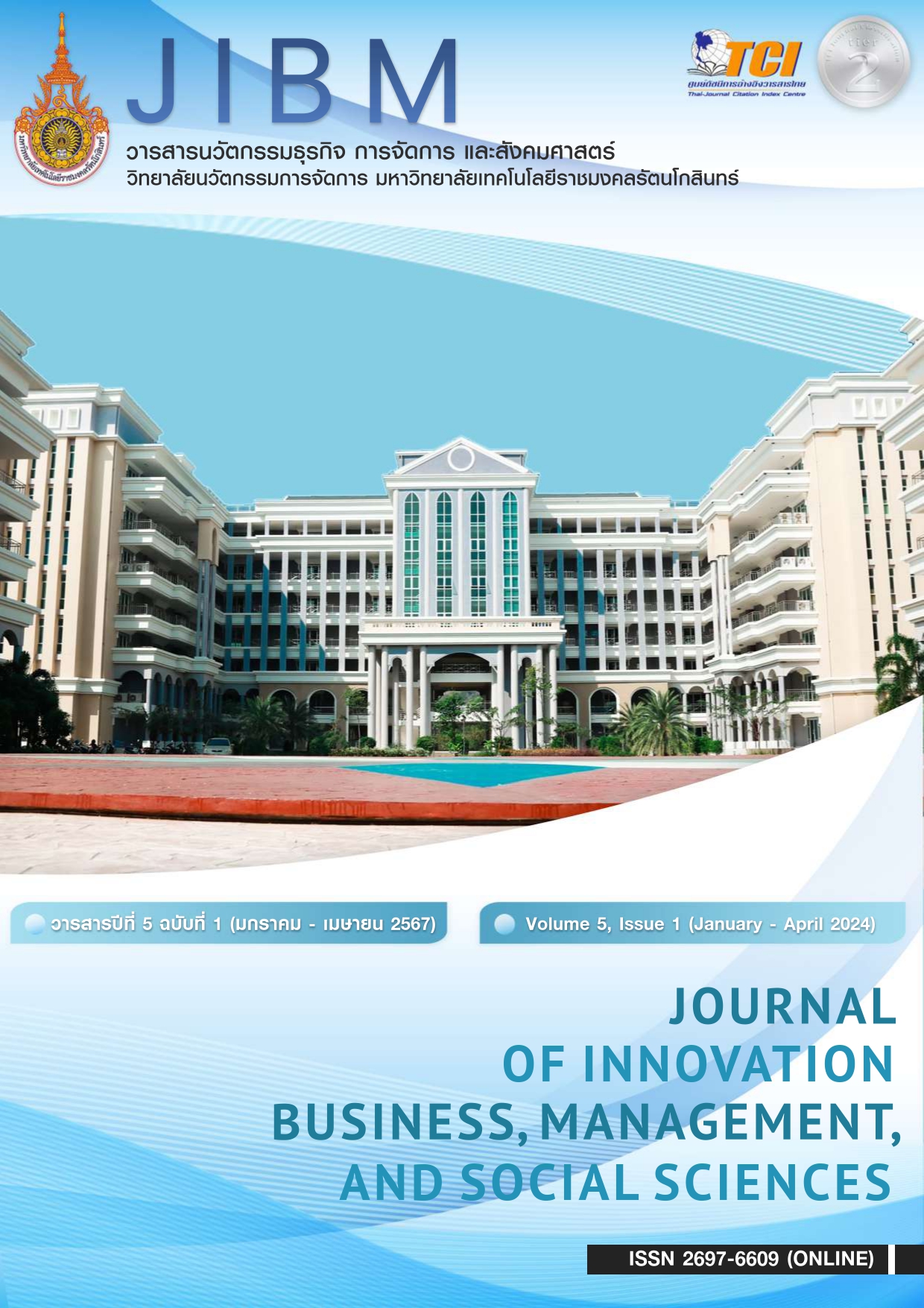การพัฒนารูปแบบการจัดการแข่งขันกีฬาตามแนวทางที่เป็นมิตรต่อสิ่งแวดล้อม : กรณีศึกษายูยิตสู กีฬาเยาวชนแห่งชาติ รอบคัดเลือกภาค 5 ครั้งที่ 39 “แม่ฮ่องสอนเกมส์ 2023”
คำสำคัญ:
แนวทางที่เป็นมิตรต่อสิ่งแวดล้อม, ประสิทธิผลองค์กร, การจัดการแข่งขันกีฬา, ยูยิตสู , แม่ฮ่องสอนเกมส์บทคัดย่อ
งานวิจัยนี้มีวัตถุประสงค์ 3 ประการ ได้แก่ (1) ระบุสภาพปัญหาการจัดการแข่งขันยูยิตสู กีฬาเยาวชนแห่งชาติ รอบคัดเลือกภาค 5 ย้อนหลัง 6 ครั้งที่ผ่านมา (2) พัฒนารูปแบบการจัดการแข่งขันยูยิตสู กีฬาเยาวชนแห่งชาติ รอบคัดเลือกภาค 5 ตามโมเดลแนวทางที่เป็นมิตรต่อสิ่งแวดล้อม และ (3) ประเมินผลการจัดการแข่งขันยูยิตสู กีฬาเยาวชนแห่งชาติ รอบคัดเลือกภาค 5 ครั้งที่ 39 ตามแนวทางที่เป็นมิตรต่อสิ่งแวดล้อม รูปแบบการวิจัยเป็นแบบผสานวิธี การวิจัยเชิงคุณภาพมีกลุ่มผู้ให้ข้อมูล ได้แก่ คณะกรรมการจัดการแข่งขันยูยิตสู กีฬาเยาวชนแห่งชาติ รอบคัดเลือกภาค 5 จำนวน 18 คน และผู้ทรงคุณวุฒิ จำนวน 7 คน การวิจัยเชิงปริมาณมีกลุ่มตัวอย่างเป็นผู้มีส่วนร่วมในการจัดการแข่งขันยูยิตสู กีฬาเยาวชนแห่งชาติ รอบคัดเลือกภาค 5 ครั้งที่ 39 จำนวน 534 คน เครื่องมือที่ใช้ในการวิจัย ได้แก่ แบบสัมภาษณ์กึ่งโครงสร้าง และแบบสอบถามแบบออนไลน์ วิเคราะห์ข้อมูลโดยใช้เทคนิคการสรุปใจความสำคัญ และการพรรณนาวิเคราะห์ ผลการวิจัยพบว่า (1) การแข่งขันยูยิตสู กีฬาเยาวชนแห่งชาติ รอบคัดเลือกภาค 5 มีการใช้วัสดุอุปกรณ์ชีวภาพจำนวนน้อย เกิดของเสียเหลือใช้จำนวนมาก ขาดการประเมินผลกระทบต่อสิ่งแวดล้อม และยังไม่สามารถสร้างมูลค่าเพื่อดึงดูดความสนใจของผู้มีส่วนได้ส่วนเสีย (2) รูปแบบการจัดการแข่งขันยูยิตสู กีฬาเยาวชนแห่งชาติ รอบคัดเลือกภาค 5 ตามโมเดลแนวทางที่เป็นมิตรต่อสิ่งแวดล้อม ประกอบด้วยหลักการสำคัญ ได้แก่ การส่งเสริมการใช้ทรัพยากรชีวภาพในท้องถิ่น เน้นการหมุนเวียนวัสดุอุปกรณ์ และใช้ระบบดิจิทัลเพื่อลดการสร้างคาร์บอน โดยมีค่าดัชนีความเหมาะสมจากการวิเคราะห์ปัจจัยเชิงยืนยันเท่ากับ 0.987 และ (3) ผลการจัดการแข่งขันยูยิตสู กีฬาเยาวชนแห่งชาติ รอบคัดเลือกภาค 5 ครั้งที่ 39 ตามแนวทางที่เป็นมิตรต่อสิ่งแวดล้อมเกิดคุณค่าของการจัดการแข่งขันและประสบความสำเร็จในระดับมากที่สุด
เอกสารอ้างอิง
Adler, R. H. (2022). Trustworthiness in qualitative research. Journal of Human Lactation, 38(4), 598-602.
Baohinlad, S., & Chankuna, D. (2022). Marketing mix factors affecting customer’s decision making in purchase sports equipment products through Facebook application for business of customers in Muang district, Chon Buri province. MUT Journal of Business Administration, 19(1), 65-82.
Bugge, M. M., Hansen, T., & Klitkou, A. (2016). What is the bioeconomy? A review of the literature. Sustainability, 8(7), 1-22.
Chankuna, D. (2018). Confirmatory factor analysis of effective fitness centers in Bangkok metropolitan region. Academic Journal Institute of Physical Education, 10(1), 65-76.
Chankuna, D. (2020). Structural equation model of effective fitness centers in Bangkok metropolitan and vicinity region). Academic Journal of Thailand National Sports University, 12(1), 85-96.
Chankuna, D. (2023). Managing for sport organizational effectiveness. Bangkok: CU Press.
Chankuna, D. (2023). Perception of FIFA World Cup Qatar 2022 socio-economic impacts in Chon Buri Sports City residents. Srinakharinwirot Business Journal, 14(1), 83-96.
Chankuna, D., & Sriboon, N. (2022). Fitness center marketing in Thailand: Antecedents and consequences of COVID-19 pandemic. In. R. M. Crabtree & J. J. Zhang (Eds.). Sport Marketing in a Global Environment: Strategic Perspectives (pp. 34-50). Abingdon, United Kingdom: Routledge.
Chankuna, D., Chanthonsarasom, A., Inchana, K., Sukdee, T., & Sriboon, N. (2021). Impact of COVID-19 on sport industry in Thailand. Academic Journal of Thailand National Sports University, 13(2), 263-276.
Chutiphongdech, T., & PHOB-UDOM, P. (2022). The BCG economy model and its application for sports event management in Thailand. Journal of Sports Science and Technology, 22(2), 13-31.
D’Amato, D., Droste, N., Allen, B., Kettunen, M., Lahtinen, K., Korhonen, J., Leskinen, P., Matties, B. D., & Toppinen, A. (2017). Green, circular, bio economy: A comparative analysis of sustainability avenues. Journal of Cleaner Production, 168(1), 716-734.
Duangsa, B., Saorom, V., & Wongkam, K. (2019). Green hotel management model for creating competitive advantage in Thailand. Governance Journal, 8(1), 476-496.
Hassadinyares, P., Boonsiri, P., & Sattanurak, S. (2020). State anxiety of athletes under the sports development project for sports hero, region 5 participating at the 34th National Youth Games in Nan province. Academic Journal of Thailand Sports University, 12(3), 204-214.
Hu, L. T. & Bentler, P. M. (1999). Cutoff criteria for fit indices in covariance structure analysis: conventional criteria versus new alternatives. Structural Equation Modeling: A Multidisciplinary Journal, 6(1), 1-55.
Jeenaboonrueang, S. (2022). Driving business with BCG economy: A case study of Doitung grains partnership limited. Academic Journal Phranakhon Rajabhat University, 13(2), 48-65.
Kline, R. B. (2015). Principles and practice of structural equation modeling. 4th ed. New York, NY: The Guilford Press.
Kongkaew, P. (2014). The development a sport and exercise management model by subdistrict administrative organizations for elders operated in the upper North. Rajabhat Chiangmai Research Journal, 15(1), 15-26.
Kyriazos, T. (2018). Applied psychometrics: Sample size and sample power considerations in factor analysis (EFA, CFA) and SEM in general. Psychology, 9(8), 2207-2230.
Lakkhongkha, K., Pornpundejwittaya, P., & Silpcharu, T. (2023). Guidelines for the growth of SMEs in the Thai sports industry. International Journal of Professional Business Review, 8(5), 1-14.
Loiseau, E., Saikku, L., Antikainen, R., Droste, N., Hansjürgens, B., Pitkanen, K., Leskinen, P. Kuikman, P. & Thomsen M. (2016). Green economy and related concepts: An overview. Journal of Cleaner Production, 139(15), 361-371.
Quinn, R. E. & Rohrbaugh, J. (1981). A competing values approach to organizational effectiveness. Public Productivity Review, 5(2), 122-140.
Quinn, R. E. & Rohrbaugh, J. (1983). A spatial model of effectiveness criteria: Towards a competing values approach to organizational analysis. Management Science, 29(3), 363-377.
Rattakul, C., Inprom, P., & Kaewchua, S. (2023). Event management evaluation of Asian Unver 23 Fencing Championship 2019. Journal of Health, Physical Education and Recreation, 49(2), 202-216.
Research and Innovation Policy Council for Bio-Circular-Green Economy (2022). BCG in action: Development of Thailand's science, technology and innovation for bio-economy, circular economy and green economy [White paper]. Retrieved from: https://www.nxpo.or.th/th/wp-content/uploads/2019/03/BCG_WhitePaper201811051.pdf, September 5, 2022.
Sirirat, J. (2021). The past and present Tokyo Olympics: The promotion of national branding from peace-loving to green nation. Japanese Studies Journal, 38(1), 114-130.
Strauss, A., & Corbin, J. (1990). Basics of qualitative research: grounded theory procedures and techniques. Newbury Park, CA: Sage.
Thawornprom, S. (2018). Sustainable model of development for volleyball competition management of Petvittayakam school. Journal of Roi Et Rajabhat University, 12(2), 134-148.
Wongprasert, J., Kheovichai, K., & Boonkoum, W. (2023). Developing a community participation model of recreation, tourism, and sport activities for Tha Kanun subdistrict, Thong Pha Phum district, Kanchanaburi province. Integrated Social Science Journal, Faculty of Social Science and Humanities, Mahidol University, 10(2), 192-211.



